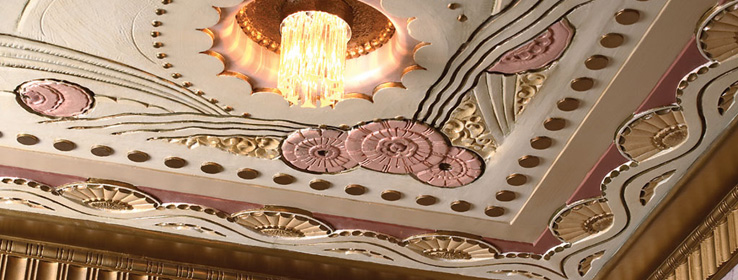Paint and plaster restore the lost Art Deco ceiling of the Twin Cities' Foshay Tower.
Any major makeover is bound to have a few surprises which, fortunately, was the case for one of Minnesota's top landmarks. Built in 1929, the Foshay Tower was modeled after the Washington Monument and soars above the city of Minneapolis at 447 feet.
Over the decades, the once-glorious skyscraper – complete with observation deck – became mundane office space. But in the fall of 2006, Starwood Hotels & Resorts Worldwide, Inc. – the company that invented the hip W Hotels – took over, converting the interior into one of its signature, sleek boutique hotels while still preserving its distinctive character and elements of the original architecture and design.
Still, no one was prepared for what would be uncovered in the lobby. When they opened up the drywall in the ceiling of the ground-floor arcade, there it was – an original, albeit severely damaged, Art Deco ceiling straight out of the '20s. And everyone knew it had to be restored.
"Eighty percent of the ceiling was original plaster," says project manager Scott Casanova of Ryan Companies. "[The U.S. National Parks Serivce] said we couldn't tear it down, but we could add on or cover it up." Previous renovations had already added dropped ceilings, punching in several holes for lighting. This process had further damaged the intricate moldings and plasterwork above.
Since the Foshay is on the National Register of Historic Places, preserving its character was in the best interest of everyone involved. Luckily, principal designer Alessandro Munge of Toronto-based Munge Leung Design Associates was already on board, and his overall vision for the building was to restore its original aesthetic charm. Knowing how important the Foshay once was to Minnesotans, Munge decided to play off the imagery of the Roaring '20s throughout the hotel, which fit nicely with plans to preserve the ceiling.
For the entire renovation, Munge, Casanova and general contractor Joel Schurke relied on original drawings and photographs to preserve the integrity of the Foshay. Such photos became essential when they encountered the arcade ceiling and cornice. Although black and white, the pictures portrayed shiny surfaces, suggesting which finishes were used where.
To help with the restoration process, they enlisted Evergreene Painting Studios to perform a paint analysis and investigation. This involves "micro exposures" using Exacto knives and chemicals to determine the original finishes.
"We identify the key architectural elements where there might have been a change of material," says project director Patty Zimmerman, adding that while the analysis is scientific, the interpretation and restoration process requires artistic expertise. For an ornamental plaster ceiling with metallic highlights and multiple glazes, this is a tough task.
The big challenge came when they discovered three of the octagonal coffers in the ceiling bays had been rebuilt with "rough construction," meaning all of the historic material was completely gone, likely due to the punctures in the dropped ceiling. In this case the team had to extrapolate based on findings in other areas to assess what had been there.
"It was a pretty ridiculous amount of damage, done at a time when people lost respect for plaster craft hand-sculpted by Italian artists," says Zimmerman.
Aside from the structural changes, the appearance was also affected by "heavy accumulation of dirt, oxidation of the metallic bronze paint, repainting, and a degree of oil migration and associated varnish formation on the surface of the paint layer," states the analysis. This all contributed to considerable darkening across the surface. Because warm palettes with very specific colors were chosen during the Art Deco period "to complement and enhance the marble on the walls," Zimmerman knew how important it was to get it right.
"Reinstating the intent of the original finish on the ceiling would create a cohesive appearance to the arcade," her formal recommendation stated, adding that every element within the arcade was essential in achieving one interconnected look. "The dramatic design work, original marble wall cladding, carefully crated ornamental plaster, and interesting paint finishes found throughout the space all contribute to the high aesthetic of this interior."
In an effort to accurately determine the colors and finishes, Evergreene Painting Studios had to expose significant amounts of the ceiling, one layer at a time, while doing the least possible damage. Then the exposures were paired with corresponding color chips by using a three-dimensional color field based on hue, value and chroma. Finally, the colors were matched to Sherwin-Williams paint. Once plaster castings were made and the ceiling was removed and recast, the paint was carefully applied.
The ceiling restoration is now arguably the focal point in the building, showing off the original decoration, floral motifs and colors, which compliment the tones in the marble walls. Casanova calls the arcade spectacular – perhaps what the first visitors said about the Foshay when it first opened to the public nearly 80 years ago.
A brochure excerpt, found among the historical documents of the assistant to the president of W.B. Foshay Company, speaks to the original craftsmanship of the Foshay. It notes: "Entrance to the ground floor of the Tower is through an arcade extending from Marquette Avenue to Second Avenue, passing under the tower... using in its decoration imported Italian marble of beautiful contrasting colors, ornamental bronze and wrought iron equipment and fixtures, with ceiling and lobby dome richly colored in the modern French spirit."
The brochure, like the black and white photographs, illustrates the attention to detail put into creating this special place, and reiterates the diligence required for an authentic replication. As Zimmerman says, "If another black and white photo was taken of the arcade at the same angle, it would look exactly the same."







